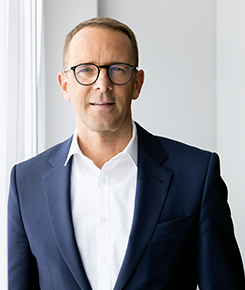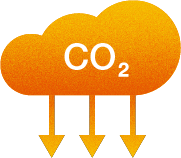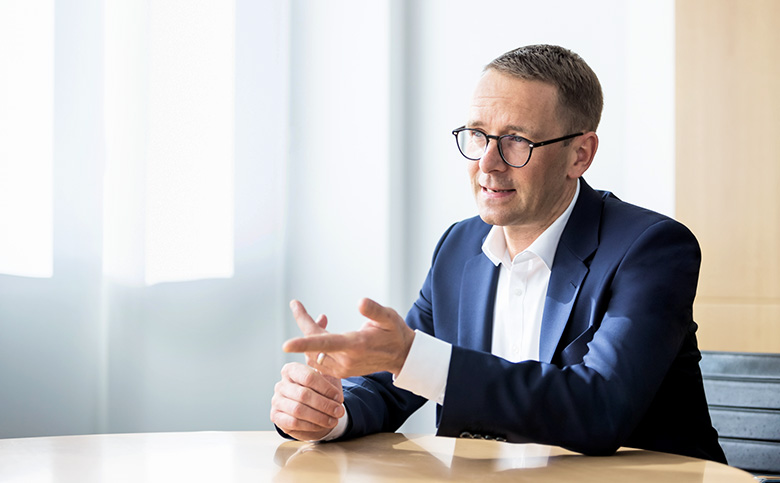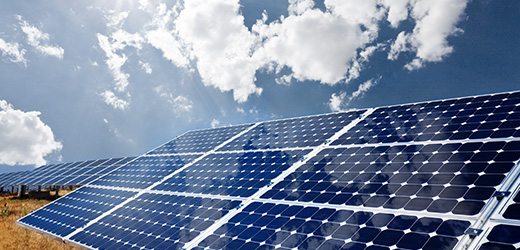Strategy
“We’re Halving Our CO2 Emissions by 2030”
WACKER aims to be net zero by 2045. Here we speak with President and CEO Christian Hartel on the levers that are available to make that happen, on what he expects from the company’s suppliers and on how the Group will help its customers launch technologies that protect the climate.
Interview with Dr. Christian Hartel

Mr. Hartel, WACKER has defined new sustainability goals. Why now? Why is that so important for a company like WACKER?
CH: Climate change is an enormous challenge, I think, and we need companies like WACKER that make their position clear and set ambitious goals. And those goals are what we need if we’re going to stop climate change and limit global warming to 1.5 degrees Celsius.
How do they differ from previous goals?
CH: The key difference is that we’re moving from specific goals to absolute goals. Up to now, we’ve always framed our efforts in terms of emissions per metric ton of finished product. But because the amount of product we make is constantly growing, that can lead to a situation where, while our production may be more sustainable, we’re still producing more emissions in an absolute sense. Now we have fixed goals that we plan to achieve – completely independent of our continued growth. That’s very ambitious.
What does that mean in concrete terms? What is the most significant environmental objective that WACKER aims to achieve by 2030?
CH: Our most important goal – the one where we have the biggest change to existing targets – concerns greenhouse gas emissions. We’re aiming to cut those in half by 2030 – and again, we’re talking about absolute numbers, regardless of how much growth we experience.

50%
fewer absolute greenhouse gas emissions
SUSTAINABILITY GOAL UNTIL 2030
Have you set any other goals beyond that?
CH: Yes, ones relating to efficiency. We’ve set two specific goals here: first off, we aim to make our energy consumption more efficient. And, second, we want to use water more conservatively, consuming less. The goal in both cases is a 15-percent reduction by 2030.

15%
drop in specific energy consumption
SUSTAINABILITY GOAL UNTIL 2030
We all know that putting the brakes on climate change won’t come without a price. How much will WACKER have to spend to actually achieve these goals?
CH: Between now and 2030 is a long time, of course. But we’ve done some estimates. The investments we will have to make are certainly significant.

15%
decrease in specific water withdrawal
SUSTAINABILITY GOAL UNTIL 2030
How do investors feel about the company spending a great deal of money on becoming more climate friendly?
CH: That’s a very good question. After all, we’re taking a two-pronged approach to improving our ecological footprint. The one component is what I call “homework.” We have to improve our own production, our processes. We’ve made it our goal, for example, to reduce our greenhouse gas emissions by 50 percent. The other component – and this is what we feel is the even more powerful lever – relates to our specialty products. These products play a critical role in helping our customers launch solutions on the market that protect the climate and conserve resources. In other words, we see sustainability as more than just money that we spend to combat climate change. It’s also a huge business opportunity for us. Yes, we’ll have to invest more. And we will, for example, if we want to achieve carbon-neutral silicon metal production at our Norway site. But in the end – and this is far more important – we’re going to be generating additional business. So looking at it that way, I’m not really worried about “pouring money” into this. These are investments in the future – investments that are going to pay off.
“Our most important goal – the one where we anticipate the biggest change to existing standards – concerns our greenhouse gas emissions. We aim to cut those in half by 2030 – and again, we’re talking about absolute numbers, regardless of how much growth we experience.”
So what proportion of our products go toward helping customers reduce their ecological footprint and become more sustainable? Is there any way to quantify that?
CH: Yes, we can quantify that. Products that allow our customers to reduce CO2 or use resources more conservatively already make up over two-thirds of our overall portfolio. In terms of applications, that cuts across the industries that account for three-quarters of global emissions – starting with the energy sector and including mobility, construction and agriculture.

100%
of key suppliers meet defined sustainability standards
SUSTAINABILITY GOAL UNTIL 2030
Could you give us some examples?
CH: We draw a distinction here between two types of products: on the one hand, those that make new technologies possible in the first place. Take our polysilicon, for example. It’s the most important starting material for solar cells. You can’t produce silicon-based solar cells without our material. On the other hand, we have products that support new environmentally sound technologies in order to make them better – technologies that, as a whole, have a major positive impact on the efforts to combat climate change. Our thermally conductive silicones are in this category. In electric vehicles, they do a much better job of dissipating the heat generated by the batteries and electronic components. If we look at all of WACKER’s products together, then a good two-thirds of them factor into our sustainable solutions expertise. I am confident that we’re in a good position there. And of course we’re not going to just rest on our laurels. We want to develop even more of these products for the future.

0
Accidents
SUSTAINABILITY GOAL UNTIL 2030
But when you make your products, you have to take account of not only greenhouse gases, but also other aspects, such as the extent to which the raw materials used are environmentally friendly. Do you take that into account?
CH: Oh definitely, that all has to be part of the overall picture. And we’re well on our way there too: 90 percent of our products already meet defined sustainability criteria. And by 2030 we want to reach 100 percent – we want our entire portfolio to meet those standards, in other words.

100%
of the WACKER portfolio meets defined sustainability standards
SUSTAINABILITY GOAL UNTIL 2030
What are the most important levers for actually achieving that?
CH: That’s a really important question, because we don’t want to just set ambitious goals, of course – we want to achieve them too. So let me mention the biggest levers:
First is carbon-neutral production of silicon metal. That’s one of WACKER’s main raw materials. Two-thirds of our products are based on silicon. And we see a lot of opportunity there, especially when it comes to carbon-neutral production of silicon metal at our own site in Holla, Norway.
The second major lever consists of process-optimization projects and new methods for using CO2 as a raw material. Through our RHYME Bavaria project, for example, we’re aiming to take green hydrogen and CO2 from existing production processes to produce green methanol.
And the third lever is green energy. Many of our processes have already been electrified – over 60 percent of them, which makes us the global leader in the chemical industry. Once we manage to switch our electrified processes over to green energy, we’ll very quickly have another, extremely powerful lever for improving our own footprint.

25%
reduction in emissions from upstream products
SUSTAINABILITY GOAL UNTIL 2030
That all sounds very positive. But what do you see as the biggest challenges and obstacles along the way? Where are the stumbling blocks?
CH: Moving forward with these projects and initiatives doesn’t just happen all by itself, of course. A lot of processes first have to be developed from scratch. But we have a clear concept pointing us in the right direction. And as far as green energy is concerned, it just stands to reason that you have to have enough of it available on the market. And that means Germany and the rest of Europe are going to have to expand renewable energies at a much faster pace.
As you’ve said, WACKER’s goals are ambitious. Will the company be able to achieve those goals on its own, or will it need support from other companies – like suppliers, for example?
CH: The goals we’ve been discussing are all ones that we’re taking upon ourselves. But becoming net zero isn’t something any single company can do on its own. Being a chemical company means we buy a lot of raw materials, and those raw materials can also carry a lot of carbon “baggage” so to speak. It’s what’s known as Scope 3 emissions, which arise along the supply chain. For WACKER, those emissions are five times as high as the greenhouse gas emissions generated by our own production lines. And that’s why we also expect our suppliers to meet defined sustainability criteria and, furthermore, significantly reduce their own greenhouse gas emissions – by 25 percent by 2030.

I’d like to finish with a personal question: what does sustainability mean to you personally?
CH: For me, sustainability means preserving what we had in the past and what we have today. Our climate, for example. Nature, the forests, water. But that also applies to our relationships, to people, to jobs. It means preserving an environment that supports human well-being. It means preserving a world where the quality of life is the same for future generations as it was for us.


